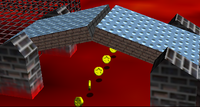Drawbridge
| Drawbridge | |
|---|---|
 Model from Super Mario 64 | |
| First appearance | Super Mario Bros. 3 (1988) |
| Latest appearance | Super Mario 3D All-Stars (2020) |
Drawbridges,[1][2] also referred to as bridges,[3] are platforms in the Super Mario series. They occur in pairs, with each one flipping up and down at the hinge.
History
Super Mario Bros. 3 / Super Mario Advance 4: Super Mario Bros. 3
Drawbridges are map features in Super Mario Bros. 3, appearing only in Water Land. The north-south drawbridges and East-West drawbridges always open in sync with each other, with one type being passable and the other type being impassible at any given time. Every time the player leaves a level, the drawbridges change state. The state of the drawbridges affects the animation of the other map features due to tile limitations, so objects such as trees animate differently depending on which direction of drawbridge is passable.
Super Mario 64 / Super Mario 64 DS
In Super Mario 64 and Super Mario 64 DS, a metallic drawbridge appears in the southwestern portion of Lethal Lava Land, connecting a path with Bullies to the wire-frame platform with a Mr. I. and a Warp Point. It opens up and closes on periodically, under its own volition. If it opens with the player character on top, they are dropped into lava.
A row of Yellow Coins is underneath the drawbridge. The player character can collect these coins by riding a Koopa Shell across the lava, but only while the drawbridge is raised.
New Super Mario Bros.
Drawbridges occur only in the underground-themed World 4-5 in New Super Mario Bros. In this game, they are segmented and yellow. Their hinges are fastened to stairblocks. They and fall on their own, and Mario (or Luigi) can ascend the drawbridges like slopes as they move. This is necessary to collect the second Star Coin in the course if Mario tosses a Bob-omb to destroy the overhanging blocks. A pair of drawbridges must be raised in order to access the sub-area that contains the final Star Coin in the course.
Gallery
Super Mario Bros. 3 (north to south, open)
Names in other languages
| Language | Name | Meaning | Notes |
|---|---|---|---|
| Japanese | 跳ね橋[4] Hanebashi |
Drawbridge | |
| Italian | Ponte salto[5] | Jump bridge |
References
- ^ Loe, Casey (2006). New Super Mario Bros.: Official Player's Guide. Redmond: Nintendo of America (American English). ISBN 1-59812-009-3. Page 58.
- ^ Knight, Michael (2010). "New Super Mario Bros. DS" in Nintendo DS Pocket Guide. Roseville: Prima Games. ISBN 978-0-307-46760-7. Page 57.
- ^ "TOAD'S MUSHROOM HOUSE: PICK A BOX After you finished 3-4, you saw that the bridge to this Toad's House (above and left of 3-4) was closed. After 3-5, it opens, allowing you to pick any box you want. A Super Leaf, Fire Flower, or Frog Suit are randomly given out." – Hodgson, David S J. (October 21, 2003). Super Mario Advance 4: Super Mario Bros. 3 Prima's Official Strategy Guide. Prima Games (American English). ISBN 0-7615-4425-9. Page 48.
- ^ Sakai, Kazuya (ambit), kikai, Akinori Sao, Junko Fukuda, Kunio Takayama, and Ko Nakahara (Shogakukan), editors (2015). "New Super Mario Bros." in 『スーパーマリオブラザーズ百科: 任天堂公式ガイドブック』. Tokyo: Shogakukan (Japanese). ISBN 978-4-09-106569-8. Page 119.
- ^ November 15, 2018. Super Mario Bros. Enciclopedia. Magazzini Salani (Italian). ISBN 889367436X. Page 119.





